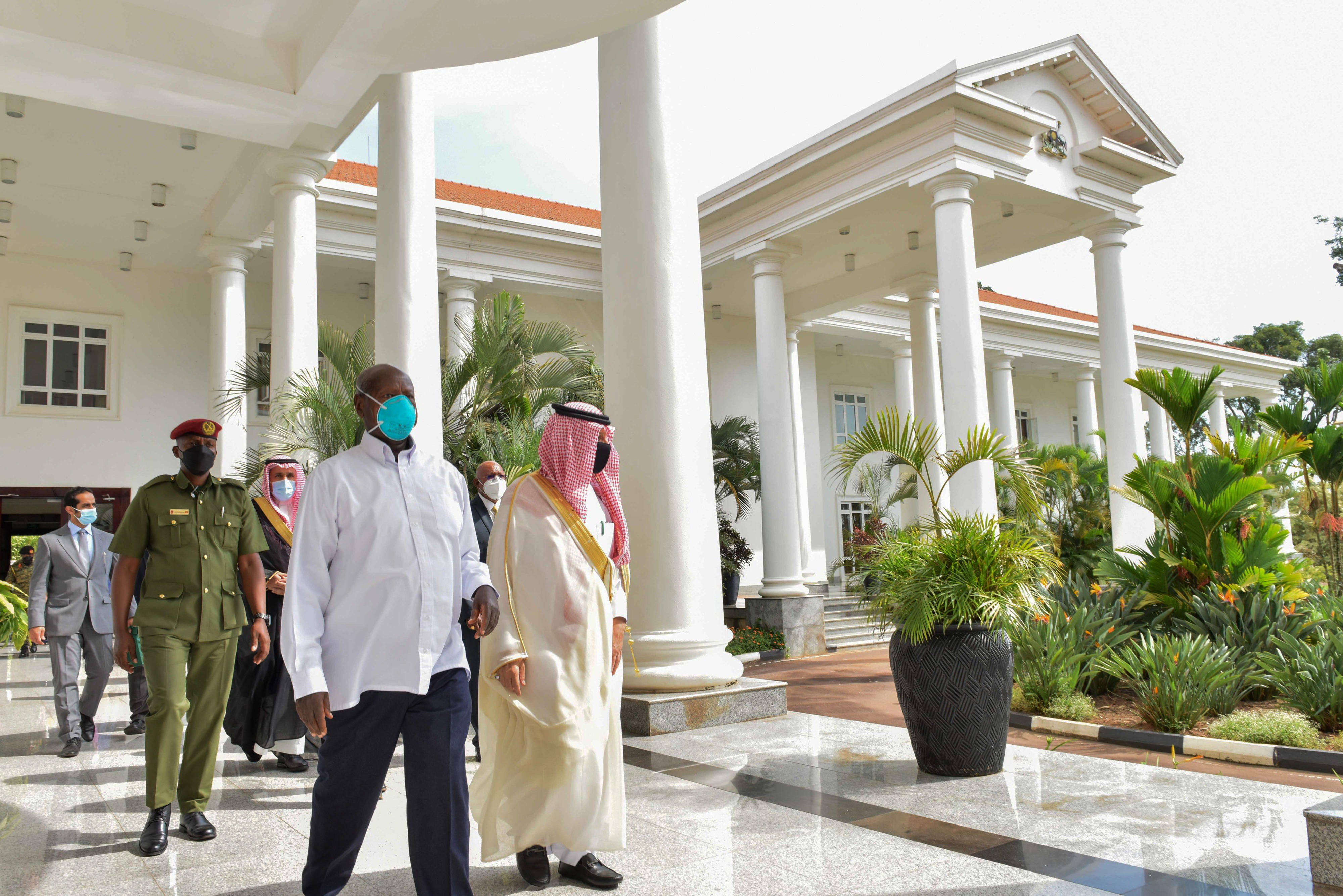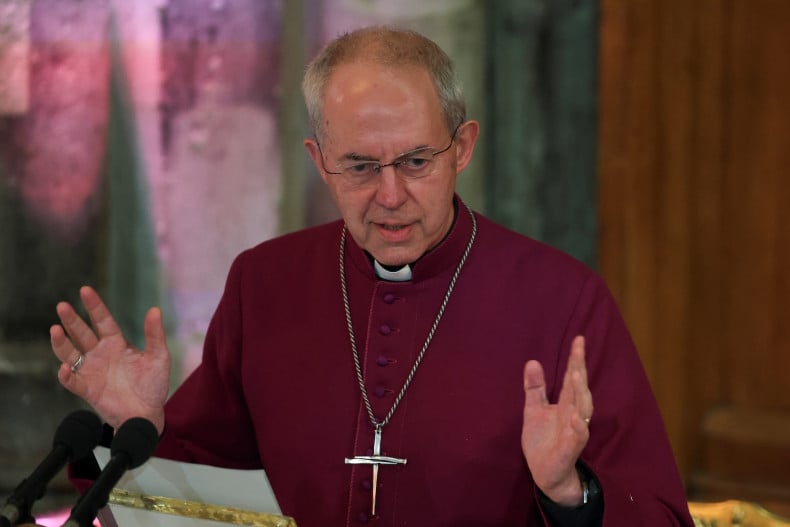Prime
State House donations nears Shs1 trillion mark

President Museveni (left) with a guest at State House, Entebbe. PHOTO/FILE
What you need to know:
- There was another Shs69 billion paid out in allowances to casual and temporary staff of State House. Such an outlay has seen calls grow in their frequency and stridency over a reduction in the size of the State House workforce.
Donations have dominated the State House’s expenditures, with figures from the Finance Ministry and the Civil Society Budget Advocacy Group (CSBAG) indicating that they gobbled Shs751 billion across seven financial years.
The computation however does not capture what was expended in the Financial Year 2017/2018.
Donations took up almost twice as much money as what went to classified expenditure and nearly three times as much as what was expended on inland travel.
Classified expenditure took up Shs342 billion and inland travel Shs275 billion.
Donations were first included in the national budgets in the Financial Year 1986/1987, the first under the National Resistance Movement-NRM.
At the time, the State House and the Office of the President did not have separate budgets. Under that budget, Shs229.1 billion of the Shs2.73 trillion budget went to the Office of the President, under which the State House was.
Donations featured with Shs5 billion allocated as “contributions to local organisations” and another Shs500 million made available for “other contributions.” Most of the organisations towards which the donations had been planned were never made known.
The amounts and allocations towards donations have been growing over the years. It reached the Shs53.7 billion mark in the Financial Year 2013/2014 when State House tabled a request in April 2013 and obtained supplementary funding to the tune of Shs138.2 billion.
Of this, Shs47 billion was to cater to presidential donations.
Whereas the Ministry of Finance announced cuts of up to 30 percent for the budgets of key ministries and government departments and agencies next financial year, another Shs83 billion has been made available for the President to donate.
Should the money actually be made available, State House will have spent at least Shs834 billion over an eight-year period.
The decision by the President to continue making donations at a time when the economy is in shambles and at a time when the government has been calling on ordinary Ugandans to be frugal has attracted sharp criticism from sections of civil society and the public.
Mr Muhammad Muwanga Kivumbi, the shadow Finance minister, who is also the Butambala County lawmaker, told Sunday Monitor that President Museveni owes the public an explanation.
“He is a servant of the people. He enjoys this power in trust.
In an ideal situation, this puts him in that space where he needs to explain to the people what he is doing with their money,” Mr Kivumbi said.
Dr Chris Baryomunsi, the Information, Communication, Technology and National Guidance minister, said thus: “With budgeting, it is just a huge framework but depending on the cash flow and liquidity some of those will eventually be cut down. We have already suppressed some key areas across the national budget.”
Among the other items that State House was found to have heavily spent on during the seven-year stretch is the provision of logistical support, welfare, and security for the President and his travels abroad.
Provision of logistical support to the President took up Shs153 billion while foreign travel took up just under Shs101 billion.
Whereas Dr Baryomunsi insists that the President has to be supported to deliver his mandate, there have always been concerns about the high cost at which that support has come. The provision of logistical support is believed to have had an influence on the Shs94 billion that was paid out as general staff salaries and an additional Shs46 billion in State House workers’ allowances.
There was also another Shs69 billion paid out in allowances to casual and temporary staff of State House.
Such an outlay has seen calls grow in their frequency and stridency over a reduction in the size of the State House workforce.
“I think there are serious areas where we e money. The Cabinet is very big and the cost of remuneration of those members is high,” Mr Arthur Bainomugisha, the executive director of the Advocates Coalition for Development and Environment (ACODE), told Monitor, adding that President Museveni has to consider reducing the size of his Cabinet if and when he makes a reshuffle.
Other areas that Dr Bainomugisha feels should be reconsidered to whittle down the public expenditure include a reduction in the security details of certain individuals, a reduction in the number of members of Parliament, and reduction in the number of resident district commissioners (RDCs).
Whereas money spent on foreign travel has also been questioned, Dr Baryomunsi has offered assurances that it will be “greatly minimised” in the next financial year.
“Ministers and staff of government will only travel in exceptional circumstances where they must travel,” Dr Baryomunsi said.
According to the documents, State House spent at least Shs24 billion on aircrafts in the period between the financial years 2015/2016 and 2022/2023. Previously, between 2000 and 2009, Uganda spent Shs148 billion on the purchase of two Gulfstream presidential jets.
The first jet, a Gulfstream IV, cost Shs60 billion and the second, the Gulfstream V, cost Shs88 billion.
A Mil Mi-171 helicopter owned by the Uganda People’s Defence Air Force, which was purchased in 2016 at a cost of approximately Shs11.3 billion, is available for the President to use, especially for internal flights
State House also spent quite heavily on the purchase and maintenance of vehicles. Whereas Sunday Monitor could not establish the actual number of vehicles acquired, the President’s official residence is found to have spent at least Shs43.7 billion on the purchase and maintenance of vehicles.
Another Shs720 million was found to have been spent on fuel, lubricants, and oils.
The size of the State House’s fleet of vehicles has been a subject of intense speculation, with some sources putting the number at well over 100.
One source, for instance, told Sunday Monitor that there are up to 120 vehicles split into three different sets for simultaneous deployment in different places as and when required.
Dr Byaryomunsi, however, insists that the President needs to be facilitated with transport in order to execute his duties.
“I do not know how many [vehicles] he has. I do not know whether they are 100, but the President has to be enabled to move.
Much as there are budgetary constraints, the President has to move and supervise government work because he is a working President,” Dr Baryomunsi reasoned, adding, “He is not just one who stays in [the] State House. He has to be enabled to reach the people and supervise like he is supervising the Parish Development Model.”
The State House has previously purchased vehicles for the President at an eye-watering amount. In October 2012, two armoured Mercedes Benz cars were acquired for Shs6 billion.
Last June, when President Museveni delivered the State of the Nation Address, he arrived at Kololo Ceremonial Grounds in a new Mercedes Benz, believed to have been a Mercedes-Benz Maybach S 680 4MATIC.
The car costs anywhere between Shs1.4 billion and Shs2.2 billion.
Other areas where State House was found to have spent heavily during the seven-year stretch include special meals and drinks that came to the tune of Shs28.5 billion; welfare and entertainment that took up Shs30 billion; and rent (Shs12.6 billion).
State house expenses in seven years
•Donations– Shs 751b
•Classified expenditure – Shs342b
• Inland travel –Shs 275b
• Logistics, welfare and security - Shs152b
• Travel abroad - Shs100b
• Staff Salaries - Shs93b
• Community outreaches- Shs90b
•Aircrafts – Shs24b
•Vehicle maintenance- Shs44b
• Transport Equipment – 26b
•Special meals and drinks – Shs29b
•Rent – Shs13b
•Welfare and entertainment - Shs30b
• Electricity – Shs9b
• Water - Shs6bn
• Furniture – 5bn




